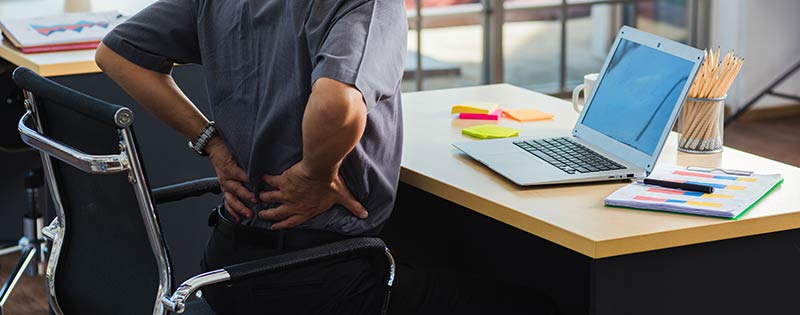by Brent Hearn •
It’s the year 2022. With the vast technological resources at our disposal, you’d think back pain would be a thing of the past. So much of the manual labor that was once our lot is now delegated to machinery or has been eliminated entirely. Most of us don’t lug animal carcasses across the tundra or walk dozens of miles in the snow; if you’re the exception to that rule, it’s probably either because you choose to live in the wilderness or you’re one of those extreme obstacle racers who paid good money for the privilege (in which case you’ll get no pity here.)
The sad truth is that many of the workplace technological advancements we love so much are contributing to our back pain. Whether it’s the technology itself (if you’re reading this on your phone, consider this your posture check for the day) or the more sedentary work that’s the norm largely because of said technology, back pain hasn’t gone anywhere. It’s almost as if we’re determined that no matter how advanced our civilization gets, we’re going to give ourselves an excuse or ten to grumble about our backs.
The good news is that, in many cases, there are things we can do to lessen or eliminate back pain at work. Read on to pick up some tips to have your back’s…back.
Move Like Your Back Depends on It
Sitting still for hours on end is bad for us in general, and it’s certainly awful for our backs. We just weren’t made to sit as much as many of us do. Here’s the kicker, though: while a standing desk can help, standing still in one position for too long isn’t great either, as it can put excess pressure on the spine.
If you spend a lot of time in front of your computer, make sure you take walking breaks. If you’re at a conference or other work event, don’t just park yourself by the punch bowl; you can always make multiple trips. (Can you tell we’re already looking ahead to holiday parties?)
Moving more has an additional perk. In conjunction with a proper diet (holiday punch notwithstanding), it can help shed excess weight, which can also take some of the load off your back. Our bodies are made for motion, so work with nature instead of against it.
Set Yourself—and Your Office—Up for Success
Even if you make an effort to take frequent standing/moving breaks, there’s still a good chance you’ll find yourself parked at a desk in front of a computer if you work a desk job. Whether said desk sits in an office building or you work remotely, it’s important to make your setup as ergonomic as possible.
- Invest in a good chair.
Look for a chair that provides good, firm support for your lower back. Adjust it to a height that puts your knees slightly higher than your hips. Yes, some of the higher-end chairs are expensive, but when you compare them to what you could save in pain, discomfort, and medical bills later, it’s a no-brainer.
- Place your monitor correctly.
Your monitor should be at a distance that doesn’t require you to lean into or away from it while working and at a height that doesn’t necessitate tilting your neck up or down in a way that causes unnecessary strain.
The Occupational Safety and Health Administration (OSHA) offers a Computer Workstations eTool to help guide you in your quest for a more ergonomic office setup.
Beware of Repetition
Repetitive tasks can cause back injury, so it’s important to work smarter, not harder. If your job requires a lot of lifting, use lifting devices appropriate to the task. (And—though it should go without saying—bend at the knees, not at the back.) If you’re on the phone a lot, use a headset. For necessary repetitive tasks with no reasonable workarounds, alternate them with less repetitive ones to reduce the chance of injury.
Sources:
BackCare: BackCare’s 40 tips for a healthier back
Chron: OSHA Guidelines for Computer Monitor Height
Healthline: 10 Daily Habits to Stop Back Pain
Mayo Clinic: Back pain at work: Preventing pain and injury
Occupational Safety and Health Administration: Computer Workstations eTool
SpineUniverse: Workstation Ergonomic Tips: Computer Monitors and Posture









 ▶︎
▶︎  Why is the Discount Challenge prize amount $15,024? Because that is the average “per-occurrence” fine for Medicare inducements. That’s not $15,024 per patient, that’s not per provider, that’s PER VISIT. Stinks, doesn’t it? To us, the prize amount is worth the investment if we can help our profession better understand proper discounting.
Why is the Discount Challenge prize amount $15,024? Because that is the average “per-occurrence” fine for Medicare inducements. That’s not $15,024 per patient, that’s not per provider, that’s PER VISIT. Stinks, doesn’t it? To us, the prize amount is worth the investment if we can help our profession better understand proper discounting.